Related Research Articles

The RWD 3 was a 1930 Polish sports aircraft and liaison aircraft prototype, constructed by the RWD team, a single-engine high-wing monoplane.

The Handley Page W.8, W.9 and W.10 were British two- and three-engine medium-range biplane airliners designed and built by Handley Page.

The de Havilland DH.50 was a 1920s British large single-engined biplane transport built by de Havilland at Stag Lane Aerodrome, Edgware, and licence-built in Australia, Belgium, and Czechoslovakia.
The Heinkel HE 1 was a two-seat, low-wing monoplane floatplane, designed in 1921 by German designer Ernst Heinkel at Caspar-Werke.

The ANEC III was a 1920s British six-seat passenger and mail carrier aircraft built by Air Navigation and Engineering Company Limited at Addlestone, Surrey.

The ANEC IV Missel Thrush was a 1920s British two-seat light aircraft built by Air Navigation and Engineering Company Limited at Addlestone Surrey.

The de Havilland DH.75 Hawk Moth was a 1920s British four-seat cabin monoplane built by de Havilland at Stag Lane Aerodrome, Edgware.
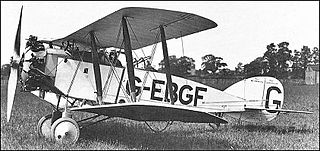
The Bristol Type 76 Jupiter Fighter and Type 89 Trainer were derivatives of the British fighter of the First World War, powered by Bristol Jupiter radial engines. While unsuccessful as a fighter, it was used as an advanced trainer aircraft between 1924 and 1933.

The Fokker F.XXXVI was a 1930s Dutch four-engined 32-passenger airliner designed and built by Fokker. It was the largest transport designed and built by Fokker.

The Saro Cloud was a British passenger amphibian flying boat designed and built by Saunders-Roe as the A.19. It was later produced as the A.29 for the Royal Air Force for pilot and navigator training.

The Fokker F.II was the first of a long series of commercial aircraft from the Fokker Aircraft Company, flying in 1919. In a biplane age, it presented a distinct clean, high-wing monoplane style that sold successfully across Europe and North America during the development of commercial passenger-carrying aviation.
The Avro 539 was a British single-seat racing biplane built by Avro for the 1919 Schneider Trophy.
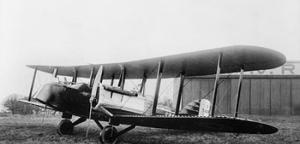
The Avro 533 Manchester was a First World War-era twin-engine biplane photo-reconnaissance and bomber aircraft designed and manufactured by Avro.
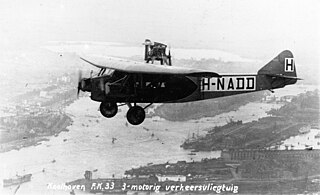
The NVI F.K.33 was an airliner built in the Netherlands in 1925 for use by KLM for night flying.
The Lasco Lascoter was a 1920s Australian 6-seat passenger and mail carrier aircraft built by the Larkin Aircraft Supply Company (Lasco) at Coode Island, Victoria. It was the first Australian-designed and built airliner to be granted a Certificate of Airworthiness.

The B.A.C. Drone was a British ultralight single-seat aircraft of the 1930s.

The Canadian Vickers Vista was a Canadian-designed single-seat flying boat.
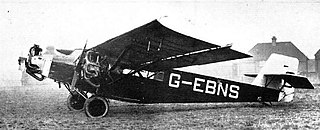
The Handley Page HP.32 Hamlet was a British six-passenger monoplane transport designed and built by Handley Page. Only one was built to order of the Air Ministry, first flown with three-engines, later changed to two then back to three engines.
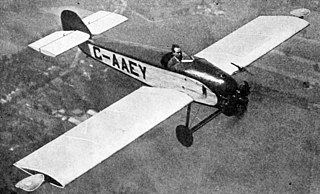
The Henderson-Glenny H.S.F.II Gadfly was a British single-seat low-wing monoplane designed by K.N. Pearson and built by Glenny and Henderson Limited at Byfleet, Surrey, England in 1929.
The Watkinson Dingbat was a 1930s British ultralight monoplane designed by E.T. Watkinson and C.W. Taylor.
References
- 1 2 3 4 5 6 Jackson 1974, p. 252
- ↑ "Registration Document – G-AAEY" (PDF). Civil Aviation Authority. Archived from the original (PDF) on 12 July 2015. Retrieved 11 July 2015.
Bibliography
- Jackson, A.J. (1974). British Civil Aircraft since 1919 Volume 3. London: Putnam. ISBN 0-370-10014-X.